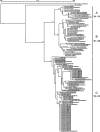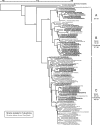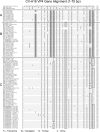Genetic diversity of coxsackievirus A16 associated with hand, foot, and mouth disease epidemics in Japan from 1983 to 2003
- PMID: 17093028
- PMCID: PMC1828949
- DOI: 10.1128/JCM.00718-06
Genetic diversity of coxsackievirus A16 associated with hand, foot, and mouth disease epidemics in Japan from 1983 to 2003
Abstract
To clarify the chronologic genetic diversity of coxsackievirus A16 (CV-A16) strains associated with hand, foot, and mouth disease (HFMD) epidemics in a restricted area and their genetic relation with those isolated in other areas, we investigated the genetic diversity of the 129 CV-A16 strains associated with HFMD epidemics in Fukushima, Japan, from 1983 to 2003, and compared their genetic relation to 49 CV-A16 strains isolated in other areas of Japan and in China by using phylogenetic analysis based on the VP4 sequences. Phylogenetic reconstruction of the CV-A16 strains isolated in Fukushima from 1983 to 2003 demonstrated three distinct genetically divergent clusters related to HFMD epidemics that occurred from 1984 to 1994 (including the 1985 and 1991 outbreaks), HFMD epidemics from 1987 to 1998 (including the 1988 and 1998 outbreaks), and HFMD epidemics from 1995 to 2003 (including the 1995 and 2002 outbreaks). CV-A16 strains isolated during each period in Fukushima formed a single cluster with those isolated during essentially the same time period in other areas of Japan and in China. Our results demonstrated that prevalent CV-A16 strains causing HFMD in Fukushima, Japan, genetically changed twice during 21 epidemics, and changes were also observed in the CV-A16 strains causing HFMD epidemics in other areas. We concluded that repeated outbreaks of CV-A16-related HFMD in Japan were caused, in part, by the introduction of genetically changed CV-A16 strains, which might be transmitted overseas.
Figures






References
-
- Chang, L. Y., T. Y. Lin, Y. C. Huang, K. C. Tsao, S. R. Shih, M. L. Kuo, H. C. Ning, P. W. Chung, and C. M. Kang. 1999. Comparison of enterovirus 71 and coxsackievirus A16 clinical illness during the Taiwan enterovirus epidemic, 1998. Pediatric. Infect. Dis. J. 18:1092-1096. - PubMed
-
- Hosoya, M., M. Sato, K. Honzumi, M. Katayose, Y. Kawasaki, H. Sakuma, K. Kato, Y. Shimada, H. Ishiko, and H. Suzuki. 2001. Association of nonpolio enteroviral infection in the central nervous system of children with febrile seizures. Pediatrics 107:E12. - PubMed
-
- Hosoya, M., Y. Kawasaki, M. Sato, K. Honzumi, A. Kato, T. Hiroshima, H. Ishiko, and H. Suzuki. 2006. Genetic diversity of enterovirus 71 associated with hand, foot, and mouth disease epidemics in Japan from1983 to 2003. Pediatr. Infect. Dis. J. 25:691-694. - PubMed
Publication types
MeSH terms
Substances
Associated data
- Actions
- Actions
- Actions
- Actions
- Actions
- Actions
- Actions
- Actions
- Actions
- Actions
- Actions
- Actions
- Actions
- Actions
- Actions
- Actions
- Actions
- Actions
- Actions
- Actions
- Actions
- Actions
- Actions
- Actions
- Actions
- Actions
- Actions
- Actions
- Actions
- Actions
- Actions
- Actions
- Actions
- Actions
- Actions
- Actions
- Actions
- Actions
- Actions
- Actions
- Actions
- Actions
- Actions
- Actions
- Actions
- Actions
- Actions
- Actions
- Actions
- Actions
- Actions
- Actions
- Actions
- Actions
LinkOut - more resources
Full Text Sources
Medical

